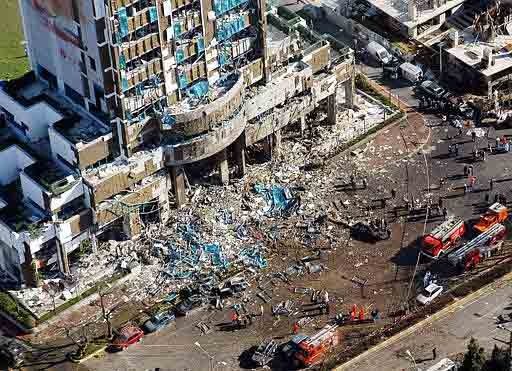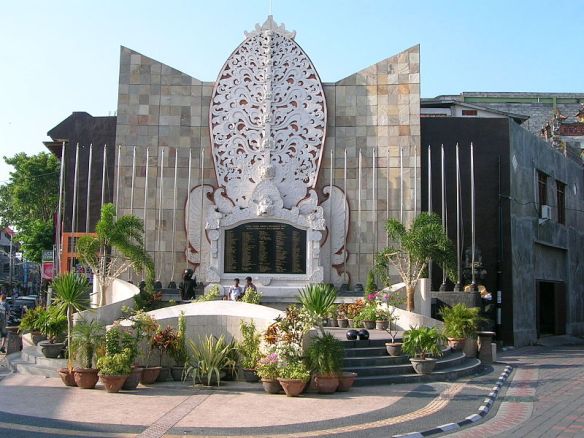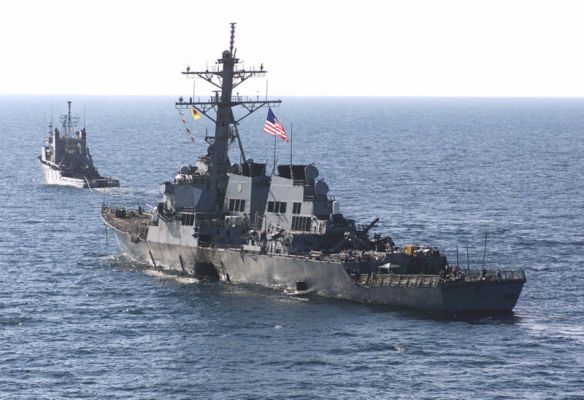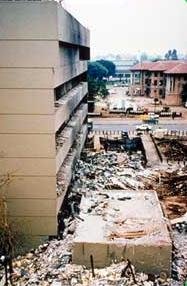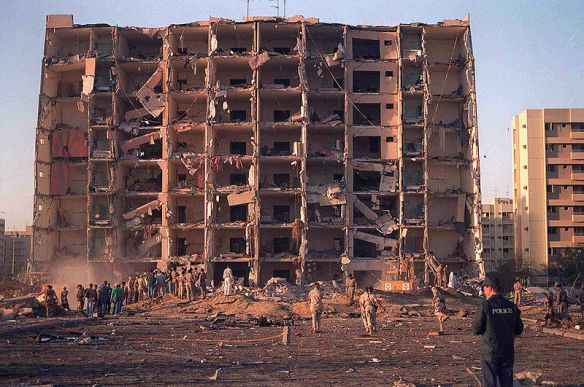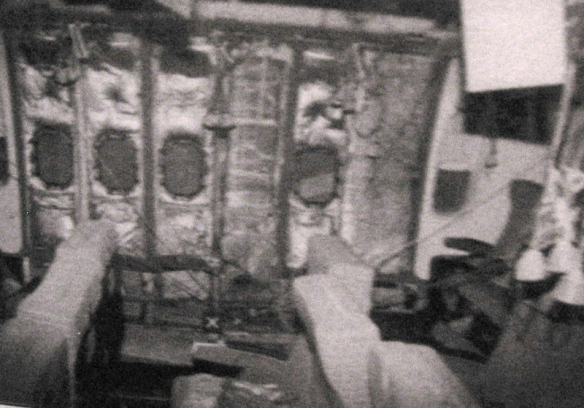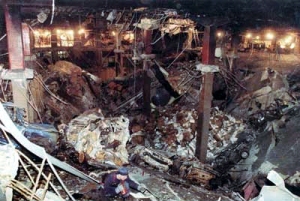
The September 11 attacks (also referred to as September 11, September 11th, or 9/11) were a series of four coordinated terrorist attacks launched by the Islamist terrorist group al-Qaeda upon the United States in New York City and the Washington, D.C. areas on September 11, 2001. On that Tuesday morning, 19 al-Qaeda terrorists hijacked four passenger jets, intending to fly them in suicide attacks into targeted buildings. Two of those planes, American Airlines Flight 11 and United Airlines Flight 175, were crashed into the North and South towers, respectively, of the World Trade Center complex in New York City. Both towers collapsed within two hours and falling debris, combined with fires that the debris initiated in several surrounding buildings, led to the partial or complete collapse of all the other buildings in the World Trade Center complex, also causing major damage to ten other large structures in the immediate area of the complex. A third plane, American Airlines Flight 77, was crashed into the Pentagon (the headquarters of the United States Department of Defense), leading to a partial collapse in its western side. The fourth plane, United Airlines Flight 93, was targeted at the United States Capitol[2] in Washington, D.C., but crashed into a field near Shanksville, Pennsylvania after its passengers tried to overcome the hijackers. Almost 3,000 people died in the attacks, including all 227 civilians and 19 hijackers aboard the four planes.
Suspicion quickly fell on al-Qaeda, and in 2004, the group’s leader, Osama bin Laden, who had initially denied involvement, claimed responsibility for the attacks.[1] Al-Qaeda and bin Laden cited U.S. support of Israel, the presence of U.S. troops in Saudi Arabia, and sanctions against Iraq as motives for the attacks. The United States responded to the attacks by launching the War on Terror and invading Afghanistan to depose the Taliban, which had harbored al-Qaeda. Many countries strengthened their anti-terrorism legislation and expanded law enforcement powers. Having evaded capture for years, bin Laden was located and killed by U.S. forces in May 2011.
The destruction of the Twin Towers and other properties caused serious damage to the economy of Lower Manhattan and had a significant effect on global markets. Cleanup of the World Trade Center site was completed in May 2002, and the Pentagon was repaired within a year. Numerous memorials have been constructed, including the National September 11 Memorial & Museum in New York, the Pentagon Memorial, and the Flight 93 National Memorial in Pennsylvania. After a lengthy delay, the 1,776-foot-tall (541 m) One World Trade Center is expected to be completed at Ground Zero in New York City in 2013.
Early on the morning of September 11, 2001, 19 hijackers took control of four commercial airliners (two Boeing 757 and two Boeing 767) en route to California (three headed to LAX in Los Angeles, and one to San Francisco) after takeoffs from Boston, Massachusetts; Newark, New Jersey; and Washington, D.C. Large planes with long flights were intentionally selected for hijacking because they would be heavily fueled.
The four flights were:
- American Airlines Flight 11: Left Boston’s Logan Airport at 7:59 a.m. enroute to Los Angeles with a crew of 11 and 76 passengers, not including five hijackers. The hijackers flew the plane into the North Tower of the World Trade Center at 8:46 a.m.
- United Airlines Flight 175: Left Logan Airport at 8:14 a.m. enroute to Los Angeles with a crew of nine and 51 passengers, not including five hijackers. The hijackers flew the plane into the South Tower of the World Trade Center at 9:03 a.m.
- American Airlines Flight 77: Left Washington Dulles International Airport in Virginia at 8:20 a.m. enroute to Los Angeles with a crew of six and 53 passengers, not including five hijackers. The hijackers flew the plane into the Pentagon at 9:37 a.m.
- United Airlines Flight 93: Left Newark International Airport at 8:42 a.m. enroute to San Francisco, with a crew of seven and 33 passengers, not including four hijackers. After the passengers revolted, the hijackers crashed the plane into the ground near Shanksville, Pennsylvania at 10:03 a.m.
Media coverage was intense during the attacks and aftermath, beginning moments after the first crash into the World Trade Center.

Events
At 8:46 a.m., five hijackers crashed American Airlines Flight 11 into the World Trade Center’s North Tower (1 WTC), and at 9:03 a.m., another five hijackers crashed United Airlines Flight 175 into the South Tower (2 WTC).Five hijackers flew American Airlines Flight 77 into the Pentagon at 9:37 a.m.
A fourth flight, United Airlines Flight 93, under the control of four hijackers, crashed near Shanksville, Pennsylvania, southeast of Pittsburgh, at 10:03 a.m. after the passengers fought the hijackers. Flight 93’s target is believed to have been either the Capitol or the White House. Flight 93’s cockpit voice recorder revealed crew and passengers tried to seize control of the plane from the hijackers after learning through phone calls that similarly hijacked planes had been crashed into buildings that morning. Once it became evident to the hijackers that the passengers might regain control of the plane, the hijackers rolled the plane and intentionally crashed it.
Some passengers and crew members who called from the aircraft using the cabin airphone service and mobile phones provided details: several hijackers aboard each plane; they used mace, tear gas, or pepper spray to overcome attendants; and some people aboard had been stabbed. Reports indicated hijackers stabbed and killed pilots, flight attendants, and one or more passengers. In their final report, the 9/11 Commission found the hijackers had recently purchased multi-function hand tools and assorted knives and blades. A flight attendant on Flight 11, a passenger on Flight 175, and passengers on Flight 93 said the hijackers had bombs, but one of the passengers said he thought the bombs were fake. The FBI found no traces of explosives at the crash sites, and the 9/11 Commission concluded that the bombs were probably fake.
Three buildings in the World Trade Center complex collapsed due to fire-induced structural failure. The South Tower collapsed at 9:59 a.m. after burning for 56 minutes in a fire caused by the impact of United Airlines Flight 175 and the explosion of its fuel. The North Tower collapsed at 10:28 a.m. after burning for 102 minutes. When the North Tower collapsed, debris fell on the nearby 7 World Trade Center building (7 WTC), damaging it and starting fires. These fires burned for hours, compromising the building’s structural integrity, and 7 WTC collapsed at 5:21 p.m. The Pentagon sustained major damage.
At 9:40 a.m., the FAA grounded all aircraft within the continental U.S., and aircraft already in flight were told to land immediately. All international civilian aircraft were either turned back or redirected to airports in Canada or Mexico, and all international flights were banned from landing on U.S. soil for three days. The attacks created widespread confusion among news organizations and air traffic controllers. Among the unconfirmed and often contradictory news reports aired throughout the day, one of the most prevalent said a car bomb had been detonated at the U.S. State Department’s headquarters in Washington, D.C. Another jet—Delta Air Lines Flight 1989—was suspected of having been hijacked, but the aircraft responded to controllers and landed safely in Cleveland, Ohio.
In a September 2002 interview, Khalid Sheikh Mohammed and Ramzi bin al-Shibh, who are believed to have organized the attacks, said Flight 93’s intended target was the United States Capitol, not the White House. During the planning stage of the attacks, Mohamed Atta, the hijacker and pilot of Flight 11, thought the White House might be too tough a target and sought an assessment from Hani Hanjour, who would later hijack and pilot Flight 77. Mohammed said al-Qaeda initially planned to target nuclear installations rather than the World Trade Center and the Pentagon, but decided against it, fearing things could “get out of control.” Final decisions on targets, according to Mohammed, were left in the hands of the pilots.
Casualties
The attacks resulted in the deaths of 2,996 people, including the 19 hijackers and 2,977 victims.The victims included 246 on the four planes (from which there were no survivors), 2,606 in New York City in the towers and on the ground, and 125 at the Pentagon.Nearly all of the victims were civilians; 55 military personnel were among those killed at the Pentagon.
More than 90% of the workers and visitors who died in the towers had been at or above the points of impact. In the North Tower 1,355 people at or above the point of impact were trapped and died of smoke inhalation, fell or jumped from the tower to escape the smoke and flames, or were killed in the building’s eventual collapse. The destruction of all three staircases in the tower when Flight 11 hit made it impossible for anyone above the impact zone to escape. One hundred-seven people below the point of impact died as well.
In the South Tower, one stairwell (A), was left intact after Flight 175 hit, allowing 14 people located on the floors of impact (including one man who saw the plane coming at him) and four more from the floors above to escape. 911 operators who received calls from individuals inside the tower were not well informed of the situation as it rapidly unfolded and as a result, told callers not to descend the tower on their own. 630 people died in that tower, fewer than half the number killed in the North Tower. Casualties in the South Tower were significantly reduced by some occupants deciding to start evacuating as soon as the North Tower was struck.
At least 200 people fell or jumped to their deaths from the burning towers (as exemplified in the photograph The Falling Man), landing on the streets and rooftops of adjacent buildings hundreds of feet below. Some occupants of each tower above the point of impact made their way toward the roof in hope of helicopter rescue, but the roof access doors were locked. No plan existed for helicopter rescues, and the combination of roof equipment and thick smoke and intense heat prevented helicopters from approaching. A total of 411 emergency workers died as they tried to rescue people and fight fires. The New York City Fire Department (FDNY) lost 340 firefighters, a chaplain and two paramedics.The New York City Police Department (NYPD) lost 23 officers. The Port Authority Police Department lost 37 officers. Eight emergency medical technicians (EMTs) and paramedics from private emergency medical services units were killed.
Cantor Fitzgerald L.P., an investment bank on the 101st–105th floors of the North Tower, lost 658 employees, considerably more than any other employer. Marsh Inc., located immediately below Cantor Fitzgerald on floors 93–100, lost 358 employees, and 175 employees of Aon Corporation were also killed. The National Institute of Standards and Technology (NIST) estimated that about 17,400 civilians were in the World Trade Center complex at the time of the attacks. Turnstile counts from the Port Authority suggest 14,154 people were typically in the Twin Towers by 8:45 a.m. The vast majority of people below the impact zone safely evacuated the buildings.
After New York, New Jersey lost the most state citizens, with the city of Hoboken sustaining the most deaths.More than 90 countries lost citizens in the attacks on the World Trade Center. Two people were added to the official death toll after dying from health conditions linked to exposure to dust from the collapse of the World Trade Center.
Weeks after the attack, the death toll was estimated to be over 6,000, more than twice the number of deaths eventually confirmed. The city was only able to identify remains for about 1,600 of the World Trade Center victims. The medical examiner’s office collected “about 10,000 unidentified bone and tissue fragments that cannot be matched to the list of the dead”. Bone fragments were still being found in 2006 by workers who were preparing to demolish the damaged Deutsche Bank Building. In 2010, a team of anthropologists and archaeologists searched for human remains and personal items at the Fresh Kills Landfill, where seventy-two more human remains were recovered, bringing the total found to 1,845. DNA profiling continues in an attempt to identify additional victims. As of August 2011, 1,631 victims have been identified, while 1,122 (41%) of the victims remained unidentified. The remains are being held in storage in Memorial Park, outside the New York City Medical Examiner’s facilities. It is expected that the remains will be moved in 2013 to a repository behind a wall at the 9/11 museum. As of July 2011, a team of scientists at the Office of Chief Medical Examiner continues to try to identify remains, in the hope that improved technology will allow them to identify other victims.
Damage
Along with the 110-floor Twin Towers, numerous other buildings at the World Trade Center site were destroyed or badly damaged, including WTC buildings 3 through 7 and St. Nicholas Greek Orthodox Church. The North Tower, South Tower, the Marriott Hotel (3 WTC) and 7 WTC were completely destroyed. The U.S. Customs House (6 World Trade Center), 4 World Trade Center, 5 World Trade Center, and both pedestrian bridges connecting buildings were severely damaged. The Deutsche Bank Building on 130 Liberty Street was partially damaged and demolished later. The two buildings of the World Financial Center also suffered damage.
The Deutsche Bank Building across Liberty Street from the World Trade Center complex was later condemned as uninhabitable because of toxic conditions inside the office tower, and was deconstructed. The Borough of Manhattan Community College’s Fiterman Hall at 30 West Broadway was condemned due to extensive damage in the attacks, and is being rebuilt. Other neighboring buildings including 90 West Street and the Verizon Building suffered major damage but have been restored. World Financial Center buildings, One Liberty Plaza, the Millenium Hilton, and 90 Church Street had moderate damage and have since been restored. Communications equipment on top of the North Tower was also destroyed, but media stations were quickly able to reroute signals and resume broadcasts.
The Pentagon was severely damaged by the impact of American Airlines Flight 77 and ensuing fires, causing one section of the building to collapse. As it approached the Pentagon, the airplane’s wings knocked over light poles and its right engine smashed into a power generator before crashing into the western side of the building, killing all 53 passengers, 5 hijackers, and 6 crew. The plane hit the Pentagon at the first-floor level. The front part of the fuselage disintegrated on impact, while the mid and tail sections kept moving for another fraction of a second. Debris from the tail section penetrated furthest into the building, breaking through 310 feet (94 m) of the three outermost of the building’s five rings.
Rescue and recovery
The New York City Fire Department deployed 200 units (half of the department) to the site. Their efforts were supplemented by numerous off-duty firefighters and emergency medical technicians.The New York City Police Department sent Emergency Service Units and other police personnel, and deployed its aviation unit. Once on the scene, the FDNY, NYPD, and Port Authority police did not coordinate efforts and performed redundant searches for civilians.As conditions deteriorated, the NYPD aviation unit relayed information to police commanders, who issued orders for its personnel to evacuate the towers; most NYPD officers were able to safely evacuate before the buildings collapsed. With separate command posts set up and incompatible radio communications between the agencies, warnings were not passed along to FDNY commanders.
After the first tower collapsed, FDNY commanders issued evacuation warnings; however, due to technical difficulties with malfunctioning radio repeater systems, many firefighters never heard the evacuation orders. 9-1-1 dispatchers also received information from callers that was not passed along to commanders on the scene.Within hours of the attack, a substantial search and rescue operation was launched. After months of around-the-clock operations the World Trade Center site was cleared by the end of May 2002.
Attackers and their background
al-Qaeda
The origins of al-Qaeda can be traced to 1979 when the Soviet Union invaded Afghanistan. Osama bin Laden traveled to Afghanistan and helped organize Arab mujahideen to resist the Soviets. Under the guidance of Ayman al-Zawahiri, bin Laden became more radical. In 1996 bin Laden issued his first fatwā, calling for American soldiers to leave Saudi Arabia.
In a second fatwā in 1998, bin Laden outlined his objections to American foreign policy with respect to Israel, as well as the continued presence of American troops in Saudi Arabia after the Gulf War. Bin Laden used Islamic texts to exhort Muslims to attack Americans until the stated grievances are reversed, and according to bin Laden, Muslim legal scholars, “have throughout Islamic history unanimously agreed that the jihad is an individual duty if the enemy destroys the Muslim countries.”
Osama bin Laden
Bin Laden, who orchestrated the attacks, initially denied but later admitted involvement. Al Jazeera broadcast a statement by bin Laden on September 16, 2001, stating, “I stress that I have not carried out this act, which appears to have been carried out by individuals with their own motivation.” In November 2001, U.S. forces recovered a videotape from a destroyed house in Jalalabad, Afghanistan. In the tape, bin Laden is seen talking to Khaled al-Harbi and admits foreknowledge of the attacks. On December 27, 2001, a second bin Laden video was released. In the video, he said, “Terrorism against America deserves to be praised because it was a response to injustice, aimed at forcing America to stop its support for Israel, which kills our people”, but he stopped short of admitting responsibility for the attacks.
Shortly before the U.S. presidential election in 2004, in a taped statement, bin Laden publicly acknowledged al-Qaeda’s involvement in the attacks on the U.S. and admitted his direct link to the attacks. He said that the attacks were carried out because, “we are free … and want to regain freedom for our nation. As you undermine our security we undermine yours.” Bin Laden said he had personally directed his followers to attack the World Trade Center. Another video obtained by Al Jazeera in September 2006 shows bin Laden with Ramzi bin al-Shibh, as well as two hijackers, Hamza al-Ghamdi and Wail al-Shehri, as they make preparations for the attacks. The U.S. never formally indicted bin Laden for the 9/11 attacks but he was on the FBI’s Most Wanted List for the bombings of the U.S. Embassies in Dar es Salaam, Tanzania, and Nairobi, Kenya. After a nearly 10-year manhunt, bin Laden was killed by American special forces in a compound in Abbottabad, Pakistan on May 2, 2011.
Khalid Sheikh Mohammed
The journalist Yosri Fouda of the Arabic television channel Al Jazeera reported that in April 2002, Khalid Sheikh Mohammed admitted his involvement, along with Ramzi bin al-Shibh. The 9/11 Commission Report determined that the animosity towards the United States felt by Mohammed, the principal architect of the 9/11 attacks, stemmed from his “violent disagreement with U.S. foreign policy favoring Israel”.
Mohammed was also an adviser and financier of the 1993 World Trade Center bombing and the uncle of Ramzi Yousef, the lead bomber in that attack.
Mohammed was arrested on March 1, 2003, in Rawalpindi, Pakistan by Pakistani security officials working with the CIA, then transported to Guantanamo Bay and interrogated using methods including waterboarding. During U.S. hearings at Guantanamo Bay in March 2007, Mohammed again confessed his responsibility for the attacks, stating he “was responsible for the 9/11 operation, from A to Z” and that his statement was not made under duress.
Other al-Qaeda members
In “Substitution for Testimony of Khalid Sheikh Mohammed” from the trial of Zacarias Moussaoui, five people are identified as having been completely aware of the operation’s details. They are bin Laden, Khalid Sheikh Mohammed, Ramzi bin al-Shibh, Abu Turab al-Urduni and Mohammed Atef. To date, only peripheral figures have been tried or convicted for the attacks.
On September 26, 2005, the Spanish high court sentenced Abu Dahdah to 27 years in prison for conspiracy on the 9/11 attacks and being a member of the terrorist organization al-Qaeda. At the same time, another 17 al-Qaeda members were sentenced to penalties of between six and eleven years. On February 16, 2006, the Spanish Supreme Court reduced the Abu Dahdah penalty to 12 years because it considered that his participation in the conspiracy was not proven.
Also in 2006, Moussaoui, who some originally suspected might have been the assigned 20th hijacker, was convicted for the lesser role of conspiracy to commit acts of terrorism and air piracy. He is serving a life sentence without parole. Mounir el-Motassadeq, an associate of the Hamburg-based hijackers, is serving 15 years for his role in helping the hijackers prepare for the attacks.
The Hamburg cell in Germany included radical Islamists who eventually came to be key operatives in the 9/11 attacks. Mohamed Atta, Marwan al-Shehhi, Ziad Jarrah, Ramzi bin al-Shibh, and Said Bahaji were all members of al-Qaeda’s Hamburg cell.
Motives
Osama bin Laden’s declaration of a holy war against the United States, and a fatwā signed by bin Laden and others calling for the killing of American civilians in 1998, are seen by investigators as evidence of his motivation.In various pronouncements before and after the attacks,al-Qaeda explicitly cited three motives for its activities against Western countries: the presence of U.S. troops in Saudi Arabia, U.S. support of Israel,and sanctions against Iraq. After the attacks, bin Laden and al-Zawahiri released additional video tapes and audio tapes, some of which repeated those reasons for the attacks. Two particularly important publications were bin Laden’s 2002 “Letter to America”, and a 2004 video tape by bin Laden.
Bin Laden interpreted the Prophet Muhammad as having banned the “permanent presence of infidels in Arabia”. In 1996, bin Laden issued a fatwā calling for American troops to leave Saudi Arabia. In 1998, al-Qaeda wrote, “for over seven years the United States has been occupying the lands of Islam in the holiest of places, the Arabian Peninsula, plundering its riches, dictating to its rulers, humiliating its people, terrorizing its neighbors, and turning its bases in the Peninsula into a spearhead through which to fight the neighboring Muslim peoples.” In a December 1999, interview, bin Laden said he felt that Americans were “too near to Mecca”, and considered this a provocation to the entire Muslim world. One analysis of suicide terrorism suggested that without U.S. troops in Saudi Arabia, al-Qaeda likely would not have been able to get people to commit suicide in this way.
In his November 2002 “Letter to America”, bin Laden cited the United States’ support of Israel as a motivation: “The creation and continuation of Israel is one of the greatest crimes, and you are the leaders of its criminals. And of course there is no need to explain and prove the degree of American support for Israel. The creation of Israel is a crime which must be erased. Each and every person whose hands have become polluted in the contribution towards this crime must pay its price, and pay for it heavily.” In 2004 and 2010, bin Laden again connected the September 11 attacks with U.S. support of Israel. Bin Laden claimed in 2004 that the idea of destroying the towers had first occurred to him in 1982, when he witnessed Israel’s bombardment of high-rise apartment buildings during the invasion of Lebanon.Several analysts, including Mearsheimer and Walt, also say one motivation for the attacks was U.S. support of Israel. In the 1998 fatwā, al-Qaeda identified the Iraq sanctions as a reason to kill Americans, condemning the “protracted blockade” among other actions constituting a declaration of war against “Allah, his messenger, and Muslims.”
In addition to those cited by bin Laden and al-Qaeda, analysts have suggested other motives, including western support of non-Islamist authoritarian regimes in Saudi Arabia, Iran, Iraq, Pakistan and northern Africa, and western troops in some of these countries. Other authors suggest that humiliation resulting from the Islamic world falling behind the Western world – this discrepancy made especially visible by recent globalization – and a desire to provoke the U.S. into a broader war against the Islamic world, in the hope of motivating more allies to support al-Qaeda. Others have argued that 9/11 was a strategic way to provoke America into a war that incites a pan-Islamic revolution.
Planning of the attacks
The idea for the attacks came from Khalid Sheikh Mohammed, who first presented it to Osama bin Laden in 1996. At that time, bin Laden and al-Qaeda were in a period of transition, having just relocated back to Afghanistan from Sudan.The 1998 African Embassy bombings and bin Laden’s 1998 fatwā marked a turning point, as bin Laden became intent on attacking the United States.
In late 1998 or early 1999, bin Laden gave approval for Mohammed to go forward with organizing the plot. A series of meetings occurred in early 1999, involving Mohammed, bin Laden, and his deputy Mohammed Atef. Atef provided operational support for the plot, including target selections and helping arrange travel for the hijackers. Bin Laden overruled Mohammed, rejecting some potential targets such as the U.S. Bank Tower in Los Angeles because, “there was not enough time to prepare for such an operation”.
Bin Laden provided leadership and financial support for the plot, and was involved in selecting participants. Bin Laden initially selected Nawaf al-Hazmi and Khalid al-Mihdhar, both experienced jihadists who had fought in Bosnia. Hazmi and Mihdhar arrived in the United States in mid-January 2000. In spring 2000, Hazmi and Mihdhar took flying lessons in San Diego, California, but both spoke little English, did poorly with flying lessons, and eventually served as secondary – or “muscle” – hijackers.
In late 1999, a group of men from Hamburg, Germany arrived in Afghanistan, including Mohamed Atta, Marwan al-Shehhi, Ziad Jarrah, and Ramzi bin al-Shibh.Bin Laden selected these men because they were educated, could speak English, and had experience living in the west. New recruits were routinely screened for special skills and al-Qaeda leaders consequently discovered that Hani Hanjour already had a commercial pilot’s license.
Hanjour arrived in San Diego on December 8, 2000, joining Hazmi. They soon left for Arizona, where Hanjour took refresher training. Marwan al-Shehhi arrived at the end of May 2000, while Atta arrived on June 3, 2000, and Jarrah arrived on June 27, 2000. Bin al-Shibh applied several times for a visa to the United States, but as a Yemeni, he was rejected out of concerns he would overstay his visa and remain as an illegal immigrant. Bin al-Shibh stayed in Hamburg, providing coordination between Atta and Mohammed. The three Hamburg cell members all took pilot training in South Florida.
In spring 2001, the secondary hijackers began arriving in the United States. In July 2001, Atta met with bin al-Shibh in Spain, where they coordinated details of the plot, including final target selection. Bin al-Shibh also passed along bin Laden’s wish for the attacks to be carried out as soon as possible.
![]() Turkey — Turkish Premier Recep Tayyip Erdoğan vowed to defeat the terrorists. “The goal of these attacks is doomed to be destroyed in the face of the government’s determination… and international solidarity in fighting terrorism,” he said. Interior Minister Abdülkadir Aksu said suicide bombers caused the explosions. Of the injured, four were in critical condition and 15 others were undergoing surgery, Istanbul health officials said. Sky Turk reporter Mustafa Azizoglu told Fox News “this is not an ordinary attack,” and said “this is the eleventh of September for Istanbul.” The explosions were “trying to target Western financial institutions,” he added. Turkish authorities said the same groups were behind Saturday’s nearly simultaneous synagogue bombings in Istanbul, which killed 23 people and the two attackers. Turkish media reported the attacks were carried out by suicide bombers, but the governor’s office said only that attackers blew up explosive-laden pickup trucks.
Turkey — Turkish Premier Recep Tayyip Erdoğan vowed to defeat the terrorists. “The goal of these attacks is doomed to be destroyed in the face of the government’s determination… and international solidarity in fighting terrorism,” he said. Interior Minister Abdülkadir Aksu said suicide bombers caused the explosions. Of the injured, four were in critical condition and 15 others were undergoing surgery, Istanbul health officials said. Sky Turk reporter Mustafa Azizoglu told Fox News “this is not an ordinary attack,” and said “this is the eleventh of September for Istanbul.” The explosions were “trying to target Western financial institutions,” he added. Turkish authorities said the same groups were behind Saturday’s nearly simultaneous synagogue bombings in Istanbul, which killed 23 people and the two attackers. Turkish media reported the attacks were carried out by suicide bombers, but the governor’s office said only that attackers blew up explosive-laden pickup trucks.![]() United States — U.S. State Department knows of no Americans killed or hurt in the blast. British Foreign Secretary Jack Straw said three or four British employees from the consulate had not reported to roll call following the blasts.
United States — U.S. State Department knows of no Americans killed or hurt in the blast. British Foreign Secretary Jack Straw said three or four British employees from the consulate had not reported to roll call following the blasts.![]() Israel — “One can hardly imagine a more tragic, violent and cruel attack than to simultaneously go after two places of worship on the Sabbath in order to kill a maximum amount of people who are busy praying and worshipping their God,” said Daniel Shek, a senior Israeli Foreign Ministry official. Deputy Prime Minister and Foreign Minister Silvan Shalom extended his condolences to Turkey and the Turkish people, the Jewish community in Turkey, and the families of the killed, and sent his wishes for a speedy recovery to those injured in today’s terrorist attacks in Istanbul, Turkey.
Israel — “One can hardly imagine a more tragic, violent and cruel attack than to simultaneously go after two places of worship on the Sabbath in order to kill a maximum amount of people who are busy praying and worshipping their God,” said Daniel Shek, a senior Israeli Foreign Ministry official. Deputy Prime Minister and Foreign Minister Silvan Shalom extended his condolences to Turkey and the Turkish people, the Jewish community in Turkey, and the families of the killed, and sent his wishes for a speedy recovery to those injured in today’s terrorist attacks in Istanbul, Turkey.![]() Syria — Syria strongly condemned the bomb attacks, calling them “terrorist”. Syrian Information Minister, Ahmad al-Hassan, expressed his country’s solidarity with Turkey, referring to the latter as “a neighbouring state and friend”. Syria also gave to the Turkish authorities 22 suspects in the bombing, who had reportedly fled Turkey after the attack.
Syria — Syria strongly condemned the bomb attacks, calling them “terrorist”. Syrian Information Minister, Ahmad al-Hassan, expressed his country’s solidarity with Turkey, referring to the latter as “a neighbouring state and friend”. Syria also gave to the Turkish authorities 22 suspects in the bombing, who had reportedly fled Turkey after the attack.![]() United Nations — The United Nations Security Council adopted Resolution 1516 on November 20, 2003, condemning the attacks and expressing sympathy to the families of the victims and to the British and Turkish governments.
United Nations — The United Nations Security Council adopted Resolution 1516 on November 20, 2003, condemning the attacks and expressing sympathy to the families of the victims and to the British and Turkish governments.
